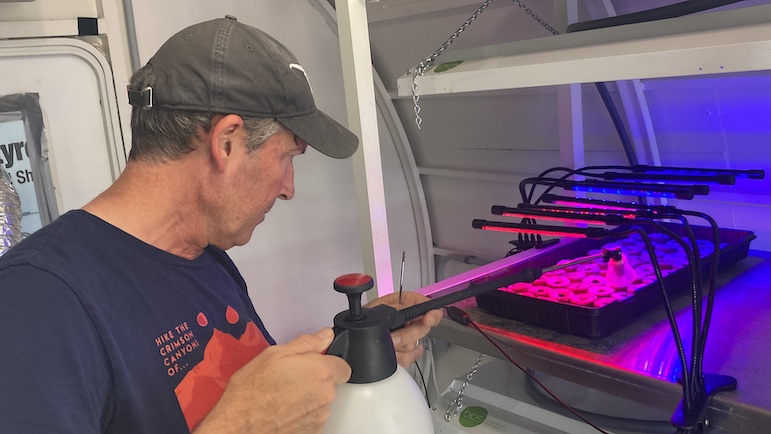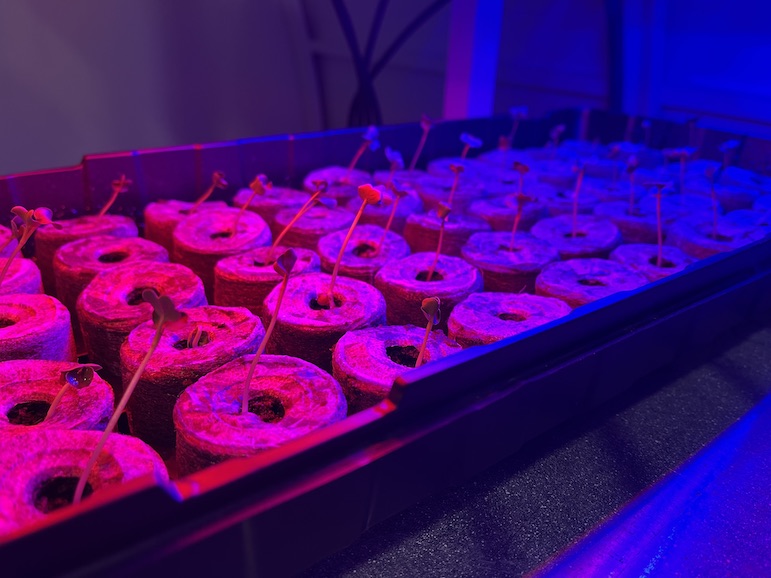A Spirulina farm. Source: stock photography site.
By Dr. Kristen Miller
Space Studies Faculty Member and Faculty Advisor, AARG, AIAA and SSG
Providing hands-on research experience for students is important at every university, but it is especially vital for students in fully virtual programs such as the University offers. Faculty-led student research groups supplement our curriculum, providing useful professional experience and fostering a sense of belonging in the University’s online community.
Dr. Ed Albin and I created the University’s Supernova Search Group (SSG) to help provide space studies students with professional research experience. This online group welcomes both undergraduate and graduate astronomy students, who gain experience in the analysis of telescope images. The group also supports research in asteroid photometry, exoplanet light curves analysis and the use of algae in space applications.
Studying the Uses of Algae in Space Environments
The SSG team lead and AMU undergraduate student Jason Cushard is interested in the uses of bioluminescent algae. He recently suggested that a group be formed to study the use of algae to grow plants in space environments such as Mars and the Moon.
This research project also involved several others:
- Terry Trevino, AMU master’s student
- Dr. Larry Harrison, AMU alumnus
- Erin Stamper, a microalgae cultivation lab supervisor at Cyanotech Corporation
- Dr. Brian Murphy, an instructor at the West Hawai’i Explorations Academy
- Emma Follis, APU undergraduate student
As the algae study group grew, the focus of the research project shifted towards spirulina, a blue-green algae known scientifically as Limnospira Fusiformis or Hawaiian Spirulina®.
Related: Aquarius: The World’s Only Undersea Research Laboratory
Why Spirulina Was a Good Choice for Exploring How to Grow Plants in Outer Space
Spirulina algae has many qualities that make it a good choice for outer space applications. These qualities include:
- Temperature and radiation resistance
- Nutritional value
- Pharmaceutical applications
- An ability to reclaim wastewater
In addition, spirulina is an effective biofertilizer. In experiments on Earth, spirulina has increased the nutritional value and production rates of a wide variety of plants.
Furthermore, spirulina has been shown to support plant health in heavy metal-contaminated, highly alkaline soils. Consequently, it is a promising choice for growing plants in the harsh lunar and Martian regolith.
Regolith is a term given to soil that has no organic material and is generally unsupportive of plant growth. Human settlements on the Moon and Mars will need to find ways to grow plants in regolith in order to be self-supporting, which is known as In-Situ Resource Utilization (ISRU). Spirulina can help with growing plants in such harsh environments.
Spirulina is also interesting because of its many potential uses in outer space. For instance, it could be used as a dietary supplement, an atmospheric carbon dioxide processor and an oxygen producer.
Spirulina’s wide range of uses make it a promising candidate for supporting future space settlements through a closed-loop system. For instance, spirulina could be cultivated in wastewater treatment systems and then harvested. It could be used to support agriculture, supplement dietary needs and even improve atmospheric conditions within an outer space habitat.
Closed-loop systems are a form of Bioregenerative Life Support Systems (BLSS), and they are essential for survival in the harsh environment of space. As a microalgae that could play a key role in both ISRU and BLSS environments, spirulina could be important in future manned space missions.
How We Conducted the Algae Research
The algae research group’s goal was to explore the benefits of using spirulina in outer space agriculture. The study began by examining how spirulina could be used as a biofertilizer to support the healthy growth of vascular plants in simulated Martian regolith.
This pilot study focused on growing Raphanus sativus (organic Daikon radish) microgreens in a soil mixture that was 80% simulated regolith and 20% soil. Microgreens are rich in vitamins and minerals. They grow very quickly, which made them a good choice for this research project.
Terry Trevino, a seasoned analog astronaut and AMU graduate student, performed the initial study at the Inflatable Lunar/Mars Analog Habitat (ILMAH). ILMAH is owned and operated by the University of North Dakota (UND)’s Human Spaceflight Laboratory.

For the research project, Terry planted a set of 10 radish plants in a mixture of regolith and soil and another 10 plants in plain soil as a control group. All of the plants were fertilized daily with a spirulina solution.


Terry found that the plants grown in regolith sprouted in about the same time as the control plants. The regolith plants did not achieve the same height as the control plants, but their roots were healthy. Also, the mass of the regolith plants after harvest was actually higher than the control plants.

Related: Outer Space: We Need to Establish Jurisdiction and Laws Now
An Initial Study Leads to the University’s First-Ever NASA Research Grant
The results of Terry’s initial research study at ILMAH showed that plants can grow in regolith if they are fertilized with spirulina. Based on the promising results of the initial study, we applied for a National Aeronautics and Space Administration (NASA) EPSCoR Rapid Response Research (R3) grant through the West Virginia Space Grant Consortium. R3 grants help universities and colleges that do not regularly receive government funding to perform research that supports NASA’s space exploration goals.
We are honored to be the first group at the University to be awarded a NASA research grant. The funds from this NASA research grant will enable us to perform a much larger and more detailed study of the effectiveness of spirulina as a biofertilizer in outer space. In addition, we will be able to confirm and quantify the results from the pilot study.
Proposed Algae Research
Using the R3 grant, we will perform a comprehensive study on the benefits of the use of spirulina as a growth bioremediation for Daikon radish microgreens. These plants will be grown under a variety of conditions similar to those found in outer space.
One of the main challenges that space agriculture must overcome is plant growth in regolith. Our study will compare plants grown in:
- Regular soil
- Different concentrations of simulated lunar regolith
- Different concentrations of simulated Martian regolith
One of the objectives of this study will be to quantify the extent to which spirulina algae can compensate for the unsupportive properties of the regolith.
Another challenge in space habitats is elevated levels of carbon dioxide, which are common when humans live in closed environments where air is processed and recirculated continuously. We will study plants grown at both atmospheric and elevated levels of carbon dioxide with the support of spirulina. Also, we will compare plant growth in a controlled laboratory setting with plant growth in a space analog habitat, provided by ILMAH.
The effect of non-terrestrial levels of gravity on plants will also be an area of research. Plants on Earth rely on gravity for their water intake and healthy growth, and our study will evaluate microgreens grown at lunar levels of gravity.
To simulate gravity on the lunar surface, the study will use a programmable random positioning machine. This machine will rotate the samples in three dimensions, independently and randomly, to simulate non-Earthlike levels of gravity in a laboratory.
In each phase of our study, we will evaluate the ability of spirulina to overcome outer space’s environmental challenges, support plant growth and improve nutritional value in Daikon radish microgreens. Overall, we will grow approximately 1,500 plants over the one-year period of the grant.
The creation of a sustainable space settlement on places such as the Moon and Mars rests on the extent to which healthy, nutrient-rich plants can be grown in high carbon dioxide, partial gravity environments using lunar and/or Martian regolith. Our research study is a large-scale systematic effort that will be helpful in NASA’s development of an outer space settlement capable of growing its own food and supporting human life.
About the Author
Dr. Kristen Miller is a professor of space studies. She holds a B.S. in physics from Brigham Young University, a M.S. in astronomy from the University of Maryland, College Park, and a Ph.D. in astronomy from the University of Maryland, College Park. Her thesis work studied turbulence in magnetic fields in protostellar disks surrounding young stars using supercomputer simulations, investigating both the ways in which turbulence allows angular momentum transport within the disks and how coupling of the gas to the field influences the direction of the accretion flow onto the protostar.
Currently, Dr. Miller leads the Supernova Search Program, a program dedicated to detecting supernovae and other transient objects in nearby galaxies. She also leads the APUS Analog Research Group (AARG), which prepares students to serve as crew members in space analog habitats.
Dr. Miller is the faculty advisor for the University’s student chapter of the American Institute of Aeronautics and Astronautics (AIAA). She is also the co-Editor in Chief of the Space Education and Strategic Applications (SESA) Journal.

Comments are closed.